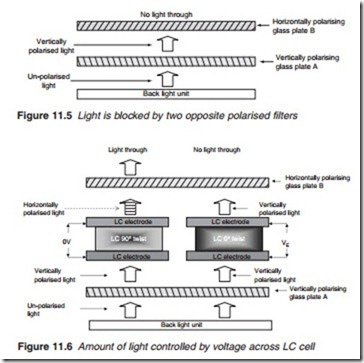Reflective and transmissive
An LC does not produce light, so the technology is ‘non-emissive’ and therefore does not give off a glow like a cathode ray tube (CRT) or a plasma panel does. An external form of light is therefore necessary which may be provided in two ways for two types of LC displays: reflective and transmissive. In the reflective type, the change in the molecular structure controls the reflected light while in the transmissive type it controls the light passing through it. The former is dependent on an external or ambi- ent light for its brightness while the transmissive type has its own backlight and is not dependent on ambient light. For this reason, the transmissive type is the more popular of the two. In either case, the voltage across the LC controls its luminance.
The TN transmissive LCD
Consider two differently polarised filter plates placed opposite each other with a backlight unit as shown in Figure 11.5. Plate A allows only vertically polarised light through while plate B permits only horizontally polarised light. The effect of the two glass plates is to block the unpolarised light ema- nating from the backlight completely. Now, consider the same arrangement
with an LC placed between the two polarised glass plates as illustrated in Figure 11.6. The unpolarised light from the backlight passes through plate A, becomes vertically polarised and goes through the LC which, without any voltage across it, forces a 90º twist changing its polarisation from vertical to horizontal which pass through the second plate B without any hindrance. If now a voltage is applied across the LC, the 90º twist would be removed and light would be blocked. If a smaller voltage is applied, a twist angle less than 90º is introduced by the LC and low-intensity light would appear at the other end. Since the applied voltage determines the twist angle of the LC, it follows that the voltage now controls the intensity of light appearing at the other end and a greyscale may thus be obtained by varying the voltage applied across the LC.
